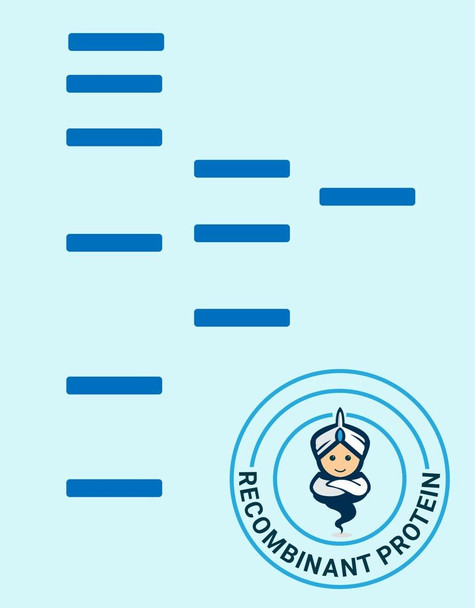Description
| Product Name: | Human UGT1A1 Recombinant Protein |
| Product Code: | RPPB2399 |
| Size: | 20µg |
| Species: | Human |
| Target: | UGT1A1 |
| Synonyms: | UDP Glucuronosyltransferase 1 Family, Polypeptide A1, UGT1,GNT1, UDP Glycosyltransferase 1 Family, Polypeptide A1, Bilirubin-SpecificUDPGT Isozyme 1, UDP-Glucuronosyltransferase 1-A, UDP-Glucuronosyltransferase1A1, EC 2.4.1.17, UDPGT 1-1, BILIQTL1, HUG-BR1, UGT1-01, UGT-1A, UGT1*1, UGT1.1,UGT1A, Bilirubin UDP-Glucuronosyltransferase Isozyme 1, BilirubinUDP-Glucuronosyltransferase 1-1, UDP-Glucuronosyltransferase 1-1, UDPGT, UDP-glucuronosyltransferase1-1. |
| Source: | Escherichia Coli |
| Physical Appearance: | Sterile Filtered clear solution. |
| Formulation: | UGT1A1 protein solution (1mg/ml) containing 20mM Tris-HCl(pH8.0) and 10% glycerol. |
| Stability: | Store at 4°C if entire vial will be used within 2-4 weeks. Store, frozen at -20°C for longer periods of time. For long term storage it is recommended to add a carrier protein (0.1% HSA or BSA).Avoid multiple freeze-thaw cycles. |
| Purity: | Greater than 90.0% as determined by SDS-PAGE. |
| Amino Acid Sequence: | MGSSHHHHHH SSGLVPRGSH MGSHAGKILL IPVDGSHWLS MLGAIQQLQQ RGHEIVVLAP DASLYIRDGA FYTLKTYPVPFQREDVKESF VSLGHNVFEN DSFLQRVIKT YKKIKKDSAM LLSGCSHLLH NKELMASLAE SSFDVMLTDPFLPCSPIVAQ YLSLPTVFFL HALPCSLEFE ATQCPNPFSY VPRPLSSHSD HMTFLQRVKN MLIAFSQNFLCDVVYSPYAT LASEFLQREV TVQDLLSSAS VWLFRSDFVK DYPRPIMPNM VFVGGINCLH QNPLSQEFEAYINASGEHGI VVFSLGSMVS EIPEKKAMAI ADALGKIPQT VLWRYTGTRP SNLANNTILV KWLPQNDLLGHPMTRAFITH AGSHGVYESI CNGVPMVMMP LFGDQMDNAK RMETKGAGVT LNVLEMTSED LENALKAVINDKSYKENIMR LSSLHKDRPV EPLDLAVFWV EFVMRHKGAP HLRPAAHDLT WYQYHSLD |
UDP Glucuronosyltransferase 1 Family Polypeptide A1, also known as UGT1A1 has a main importance in the conjugation as well as subsequent elimination of potentially toxic xenobiotics and endogenous compounds. UGT1A1 is also capable of catalyzing glucuronidation of 17beta, 17alpha, 1-hydroxypyrene, 4-methylumbelliferone, 1-naphthol, paranitrophenol, scopoletin, and umbelliferone.
UGT1A1 Human Recombinant produced in E.Coli is a single,non-glycosylated polypeptide chain containing 488 amino acids (26-490 a.a) andhaving a molecular mass of 54.7kDa.UGT1A1 is fused to a 23 amino acid His-tag at N-terminus& purified by proprietary chromatographic techniques.
| UniProt Protein Function: | UGT1A1: UDPGT is of major importance in the conjugation and subsequent elimination of potentially toxic xenobiotics and endogenous compounds. This isoform glucuronidates bilirubin IX- alpha to form both the IX-alpha-C8 and IX-alpha-C12 monoconjugates and diconjugate. Is also able to catalyze the glucuronidation of 17beta-estradiol, 17alpha-ethinylestradiol, 1-hydroxypyrene, 4- methylumbelliferone, 1-naphthol, paranitrophenol, scopoletin, and umbelliferone. Part a large chaperone multiprotein complex comprising DNAJB11, HSP90B1, HSPA5, HYOU, PDIA2, PDIA4, PDIA6, PPIB, SDF2L1, UGT1A1 and very small amounts of ERP29, but not, or at very low levels, CALR nor CANX. Expressed in liver. Not expressed in skin or kidney. Belongs to the UDP-glycosyltransferase family. 1 isoforms of the human protein are produced by alternative splicing. |
| UniProt Protein Details: | Protein type:Lipid Metabolism - androgen and estrogen; Xenobiotic Metabolism - drug metabolism - other enzymes; Xenobiotic Metabolism - metabolism by cytochrome P450; Xenobiotic Metabolism - drug metabolism - cytochrome P450; Cofactor and Vitamin Metabolism - porphyrin and chlorophyll; Membrane protein, integral; Cofactor and Vitamin Metabolism - retinol; Carbohydrate Metabolism - starch and sucrose; Carbohydrate Metabolism - pentose and glucuronate interconversions; Carbohydrate Metabolism - ascorbate and aldarate; EC 2.4.1.17; Transferase Chromosomal Location of Human Ortholog: 2q37 Cellular Component: endoplasmic reticulum membrane; integral to plasma membrane; endoplasmic reticulum Molecular Function:enzyme inhibitor activity; protein homodimerization activity; retinoic acid binding; enzyme binding; glucuronosyltransferase activity; protein heterodimerization activity; steroid binding Biological Process: response to drug; steroid metabolic process; estrogen metabolic process; negative regulation of steroid metabolic process; organ regeneration; response to lipopolysaccharide; negative regulation of fatty acid metabolic process; liver development; cellular response to hormone stimulus; response to starvation; negative regulation of transferase activity; bilirubin conjugation; flavonoid biosynthetic process; heme catabolic process; xenobiotic metabolic process; negative regulation of catalytic activity; porphyrin metabolic process; digestion; flavone metabolic process; acute-phase response; retinoic acid metabolic process; heterocycle metabolic process; drug metabolic process; response to nutrient Disease: Gilbert Syndrome; Crigler-najjar Syndrome, Type I; Bilirubin, Serum Level Of, Quantitative Trait Locus 1; Crigler-najjar Syndrome, Type Ii; Hyperbilirubinemia, Transient Familial Neonatal |
| NCBI Summary: | This gene encodes a UDP-glucuronosyltransferase, an enzyme of the glucuronidation pathway that transforms small lipophilic molecules, such as steroids, bilirubin, hormones, and drugs, into water-soluble, excretable metabolites. This gene is part of a complex locus that encodes several UDP-glucuronosyltransferases. The locus includes thirteen unique alternate first exons followed by four common exons. Four of the alternate first exons are considered pseudogenes. Each of the remaining nine 5' exons may be spliced to the four common exons, resulting in nine proteins with different N-termini and identical C-termini. Each first exon encodes the substrate binding site, and is regulated by its own promoter. The preferred substrate of this enzyme is bilirubin, although it also has moderate activity with simple phenols, flavones, and C18 steroids. Mutations in this gene result in Crigler-Najjar syndromes types I and II and in Gilbert syndrome. [provided by RefSeq, Jul 2008] |
| UniProt Code: | P22309 |
| NCBI GenInfo Identifier: | 136729 |
| NCBI Gene ID: | 54658 |
| NCBI Accession: | P22309.1 |
| UniProt Secondary Accession: | P22309,A6NJC3, B8K286, |
| UniProt Related Accession: | P22309 |
| Molecular Weight: | 533 |
| NCBI Full Name: | UDP-glucuronosyltransferase 1-1 |
| NCBI Synonym Full Names: | UDP glucuronosyltransferase 1 family, polypeptide A1 |
| NCBI Official Symbol: | UGT1A1�� |
| NCBI Official Synonym Symbols: | GNT1; UGT1; UDPGT; UGT1A; HUG-BR1; BILIQTL1; UDPGT 1-1�� |
| NCBI Protein Information: | UDP-glucuronosyltransferase 1-1; UGT-1A; UGT1*1; UGT1-01; UDP-glucuronosyltransferase 1-A; UDP-glucuronosyltransferase 1A1; bilirubin-specific UDPGT isozyme 1; bilirubin UDP-glucuronosyltransferase 1-1; bilirubin UDP-glucuronosyltransferase isozyme 1; UDP glycosyltransferase 1 family, polypeptide A1 |
| UniProt Protein Name: | UDP-glucuronosyltransferase 1-1 |
| UniProt Synonym Protein Names: | Bilirubin-specific UDPGT isozyme 1; hUG-BR1; UDP-glucuronosyltransferase 1-A; UGT-1A; UGT1A; UDP-glucuronosyltransferase 1A1 |
| Protein Family: | UDP-glucuronosyltransferase |
| UniProt Gene Name: | UGT1A1�� |
| UniProt Entry Name: | UD11_HUMAN |







